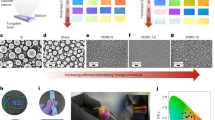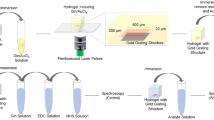Abstract
Due to its controlled reaction with water and biofluids, Mg as a dissolvable conductor has enabled the development of many transient electronic devices. In addition, Mg is a novel plasmonic material with high extinction efficiency, but its transientoptical properties have not been explored thoroughly. In this study, for the first time, we exploit the transient and tunable plasmonic properties of Mg in environmental and biomedical sensor applications. We used soft nanoimprint lithography to fabricate flexible and large-area Mg plasmonic structures that can be applied on the human skin. Their resonance (or color) can be tuned in the visible range by gradual Mg dissolution in a water fluid or vapor-rich environment; these structures can be easily implemented as passive optical sensors without the need for complex electronic circuits or a power supply. We demonstrate the applications of our optical sensors in the accurate monitoring of environmental humidity and physiological detection of sweat loss on the human skin during exercise. Our devices could be used as decomposable/resorbable optical sensors and can help minimize long-term health effects and environmental risks associated with consumer device waste, which will lead to many new possibilities in transient photonic device applications.

Similar content being viewed by others
References
Stewart, M. E.; Anderton, C. R.; Thompson, L. B.; Maria, J.; Gray, S. K.; Rogers, J. A.; Nuzzo, R. G. Nanostructured plasmonic sensors. Chem. Rev. 2008, 108, 494–521.
Yao, J. M.; Le, A.-P.; Gray, S. K.; Moore, J. S.; Rogers, J. A.; Nuzzo, R. G. Functional nanostructured plasmonic materials. Adv. Mater. 2010, 22, 1102–1110.
Liu, N.; Mesch, M.; Weiss, T.; Hentschel, M.; Giessen, H. Infrared perfect absorber and its application as plasmonic sensor. Nano Lett. 2010, 10, 2342–2348.
Valsecchi, C.; Brolo, A. G. Periodic metallic nanostructures as plasmonic chemical sensors. Langmuir 2013, 29, 5638–5649.
Mayer, K. M.; Hafner, J. H. Localized surface plasmon resonance sensors. Chem. Rev. 2011, 111, 3828–3857.
Szunerits, S.; Boukherroub, R. Sensing using localised surface plasmon resonance sensors. Chem. Commun. 2012, 48, 8999–9010.
Naik, G. V.; Shalaev, V. M.; Boltasseva, A. Alternative plasmonic materials: Beyond gold and silver. Adv. Mater. 2013, 25, 3264–3294.
MacDonald, K. F.; Zheludev, N. I. Active plasmonics: Current status. Laser Photonics Rev. 2010, 4, 562–567.
Sun, Y. H.; Jiang, L.; Zhong, L. B.; Jiang, Y. Y.; Chen, X. D. Towards active plasmonic response devices. Nano Res. 2015, 8, 406–417.
Shir, D.; Ballard, Z. S.; Ozcan, A. Flexible plasmonic sensors. IEEE J. Sel. Top. Quant. Electron. 2016, 22, 4600509.
Liu, X. Y.; Wang, X. Q.; Zha, L. S.; Lin, D. L.; Yang, J. M.; Zhou, J. F.; Zhang, L. Temperature- and pH-tunable plasmonic properties and SERS efficiency of the silver nanoparticles within the dual stimuli-responsive microgels. J. Mater. Chem. C 2014, 2, 7326–7335.
Zhu, X. L.; Shi, L.; Liu, X. H.; Zi, J.; Wang, Z. L. A mechanically tunable plasmonic structure composed of a monolayer array of metal-capped colloidal spheres on an elastomeric substrate. Nano Res. 2010, 3, 807–812.
Wu, H. X.; Wang, P.; He, H. L.; Jin, Y. D. Controlled synthesis of porous Ag/Au bimetallic hollow nanoshells with tunable plasmonic and catalytic properties. Nano Res. 2012, 5, 135–144.
Aksu, S.; Huang, M.; Artar, A.; Yanik, A. A.; Selvarasah, S.; Dokmeci, M. R.; Altug, H. Flexible plasmonics on unconventional and nonplanar substrates. Adv. Mater. 2011, 23, 4422–4430.
Vazquez-Mena, O.; Sannomiya, T.; Tosun, M.; Villanueva, L. G.; Savu, V.; Voros, J.; Brugger, J. High-resolution resistless nanopatterning on polymer and flexible substrates for plasmonic biosensing using stencil masks. ACS Nano 2012, 6, 5474–5481.
Gao, L.; Zhang, Y. H.; Zhang, H.; Doshay, S.; Xie, X.; Luo, H. Y.; Shah, D.; Shi, Y.; Xu, S. Y.; Fang, H. et al. Optics and nonlinear buckling mechanics in large-area, highly stretchable arrays of plasmonic nanostructures. ACS Nano 2015, 9, 5968–5975.
Emani, N. K.; Chung, T.-F.; Ni, X. J.; Kildishev, A. V.; Chen, Y. P.; Boltasseva, A. Electrically tunable damping of plasmonic resonances with graphene. Nano Lett. 2012, 12, 5202–5206.
Kim, J.; Son, H.; Cho, D. J.; Geng, B. S.; Regan, W.; Shi, S. F.; Kim, K.; Zettl, A.; Shen, Y.-R.; Wang, F. Electrical control of optical plasmon resonance with graphene. Nano Lett. 2012, 12, 5598–5602.
Lee, J.; Jung, S.; Chen, P.-Y.; Lu, F.; Demmerle, F.; Boehm, G.; Amann, M.-C.; Alù, A.; Belkin, M. A. Ultrafast electrically tunable polaritonic metasurfaces. Adv. Opt. Mater. 2014, 2, 1057–1063.
Sanz, J. M.; Ortiz, D.; Alcaraz de la Osa, R.; Saiz, J. M.; Gonzaĺez, F.; Brown, A. S.; Losurdo, M.; Everitt, H. O.; Moreno, F. UV plasmonic behavior of various metal nanoparticles in the near- and far-field regimes: Geometry and substrate effects. J. Phys. Chem. C 2013, 117, 19606–19615.
Appusamy, K.; Blair, S.; Nahata, A.; Guruswamy, S. Low-loss magnesium films for plasmonics. Mater. Sci. Eng. B 2014, 181, 77–85.
Appusamy, K.; Swartz, M.; Blair, S.; Nahata, A.; Shumaker-Parry, J. S.; Guruswamy, S. Influence of aluminum content on plasmonic behavior of Mg-Al alloy thin films. Opt. Mater. Express 2016, 6, 3180–3192.
Wu, P. C.; Kim, T.-H.; Suvorova, A.; Giangregorio, M.; Saunders, M.; Bruno, G.; Brown, A. S.; Losurdo, M. GaMg alloy nanoparticles for broadly tunable plasmonics. Small 2011, 7, 751–756.
Wu, P. C; Losurdo, M.; Kim, T.-H.; Garcia-Cueto, B.; Moreno, F.; Bruno, G.; Brown, A. S. Ga-Mg core-shell nanosystem for a novel full color plasmonics. J. Phys. Chem. C 2011, 115, 13571–13576.
Sterl, F.; Strohfeldt, N.; Walter, R.; Griessen, R.; Tittl, A.; Giessen, H. Magnesium as novel material for active plasmonics in the visible wavelength range. Nano Lett. 2015, 15, 7949–7955.
Jeong, H.-H.; Marka, A. G.; Fischer, P. Magnesium plasmonics for UV applications and chiral sensing. Chem. Commun. 2016, 52, 12179–12182.
Wang, Y. S.; Peterson, E. M.; Harris, J. M.; Appusamy, K.; Guruswamy, S.; Blair, S. Magnesium as a novel UV plasmonic material for fluorescence decay rate engineering in free solution. J. Phys. Chem. C 2017, 121, 11650–11657.
Hwang, S.-W.; Tao, H.; Kim, D.-H.; Cheng, H.; Song, J.-K.; Rill, E.; Brenckle, M. A.; Panilaitis, B.; Won, S. M.; Kim, Y.-S. et al. A physically transient form of silicon electronics. Science 2012, 337, 1640–1644.
Yin, L.; Cheng, H. Y.; Mao, S. M.; Haasch, R.; Liu, Y. H.; Xie, X.; Hwang, S.-W.; Jain, H.; Kang, S.-K.; Su, Y. W. et al. Dissolvable metals for transient electronics. Adv. Funct. Mater. 2014, 24, 645–658.
Yin, L.; Huang, X.; Xu, H. X.; Zhang, Y. F.; Lam, J.; Cheng, J. J.; Rogers, J. A. Materials, designs, and operational characteristics for fully biodegradable primary batteries. Adv. Mater. 2014, 26, 3879–3884.
Hwang, S.-W.; Park, G.; Cheng, H. Y.; Song, J.-K.; Kang, S.-K.; Yin, L.; Kim, J.-H.; Omenetto, F. G.; Huang, Y.; Lee, K.-M. et al. 25th anniversary article: Materials for high-performance biodegradable semiconductor devices. Adv. Mater. 2014, 26, 1992–2000.
Stewart, M. E.; Mack, N. H.; Malyarchuk, V.; Soares, J. A. N. T.; Lee, T.-W.; Gray, S. K.; Nuzzo, R. G.; Rogers, J. A. Quantitative multispectral biosensing and 1D imaging using quasi-3D plasmonic crystals. Proc. Natl. Acad. Sci. USA 2006, 103, 17143–17148.
Baca, A. J.; Truong, T. T.; Cambrea, L. R.; Montgomery, J. M.; Gray, S. K.; Abdula, D.; Banks, T. R.; Yao, J. M.; Nuzzo, R. G.; Rogers, J. A. Molded plasmonic crystals for detecting and spatially imaging surface bound species by surface-enhanced Raman scattering. Appl. Phys. Lett. 2009, 94, 243109.
Truong, T. T.; Maria, J.; Yao, J.; Stewart, M. E.; Lee, T.-W.; Gray, S. K.; Nuzzo, R. G.; Rogers, J. A. Nanopost plasmonic crystals. Nanotechnology 2009, 20, 434011.
Yao, J. M.; Le, A.-P.; Schulmerich, M. V.; Maria, J.; Lee, T.-W.; Gray, S. K.; Bhargava, R.; Rogers, J. A.; Nuzzo, R. G. Soft embossing of nanoscale optical and plasmonic structures in glass. ACS Nano 2011, 5, 5763–5774.
Le, A.-P.; Kang, S.; Thompson, L. B.; Rubakhin, S. S.; Sweedler, J. V.; Rogers, J. A.; Nuzzo, R. G. Quantitative reflection imaging of fixed Aplysia californica pedal ganglion neurons on nanostructured plasmonic crystals. J. Phys. Chem. B 2013, 117, 13069–13081.
Chanda, D.; Shigeta, K.; Gupta, S.; Cain, T.; Carlson, A.; Mihi, A.; Baca, A. J.; Bogart, G. R.; Braun, P.; Rogers, J. A. Large-area flexible 3D optical negative index metamaterial formed by nanotransfer printing. Nat. Nanotechnol. 2011, 6, 402–407.
Gao, L.; Shigeta, K.; Vazquez-Guardado, A.; Progler, C. J.; Bogart, G. R.; Rogers, J. A.; Chanda, D. Nanoimprinting techniques for large-area three-dimensional negative index metamaterials with operation in the visible and telecom bands. ACS Nano 2014, 8, 5535–5542.
Gao, L.; Kim, Y.; Vazquez-Guardado, A.; Shigeta, K.; Hartanto, S.; Franklin, D.; Progler, C. J.; Bogart, G. R.; Rogers, J. A.; Chanda, D. Materials selections and growth conditions for large-area, multilayered, visible negative index metamaterials formed by nanotransfer printing. Adv. Opt. Mater. 2014, 2, 256–261.
Li, R.; Cheng, H. Y.; Su, Y. W.; Hwang, S.-W.; Yin, L.; Tao, H.; Brenckle, M. A.; Kim, D.-H.; Omenetto, F. G.; Rogers, J. A. et al. An analytical model of reactive diffusion for transient electronics. Adv. Funct. Mater. 2013, 23, 3106–3114.
Mena-Bravo, A.; Luque de Castro, M. D. Sweat: A sample with limited present applications and promising future in metabolomics. J. Pharmaceut. Biomed. 2014, 90, 139–147.
Jadoon, S.; Karim, S.; Akram, M. R.; Khan, A. K.; Zia, M. A.; Siddiqi, A. R.; Murtaza, G. Recent developments in sweat analysis and its applications. Int. J. Anal. Chem. 2015, 2015, 164974.
Heikenfeld, J. Non-invasive analyte access and sensing through eccrine sweat: Challenges and outlook circa 2016. Electroanalysis 2016, 28, 1242–1249.
Salvo, P.; Di Francesco, F.; Costanzo, D.; Ferrari, C.; Trivella, M. G.; De Rossi, D. A wearable sensor for measuring sweat rate. IEEE Sens. J. 2010, 10, 1557–1558.
Huang, X.; Liu, Y. H.; Chen, K. L.; Shin, W.-J.; Lu, C.-J.; Kong, G.-W.; Patnaik, D.; Lee, S.-H.; Cortes, J. F.; Rogers, J. A. Stretchable, wireless sensors and functional substrates for epidermal characterization of sweat. Small 2014, 10, 3083–3090.
Gao, W.; Emaminejad, S.; Nyein, H. Y. Y.; Challa, S.; Chen, K.; Peck, A.; Fahad, H. M.; Ota, H.; Shiraki, H.; Kiriya, D. et al. Fully integrated wearable sensor arrays for multiplexed in situ perspiration analysis. Nature 2016, 529, 509–514.
Choi, J.; Kang, D.; Han, S.; Kim, S. B.; Rogers, J. A. Thin, soft, skin-mounted micro fuidic networks with capillary bursting valves for chrono-sampling of sweat. Adv. Healthcare Mater. 2017, 6, 1601355.
Koh, A.; Kang, D.; Xue, Y. G.; Lee, S.; Pielak, R. M.; Kim, J.; Hwang, T.; Min, S.; Banks, A.; Bastien, P. et al. A soft, wearable microfluidic device for the capture, storage, and colorimetric sensing of sweat. Sci. Transl. Med. 2016, 8, 366ra165.
Acknowledgements
The author acknowledges support from the Natural Science Foundation of Jiangsu Province (No. BK20150790), the National Natural Science Foundation of China (Nos. 11604151, 61734003, and 61521001), the Fundamental Research Funds for the Central Universities (No. 30917015103).
Author information
Authors and Affiliations
Corresponding authors
Electronic supplementary material
Rights and permissions
About this article
Cite this article
Li, R., Xie, S., Zhang, L. et al. Soft and transient magnesium plasmonics for environmental and biomedical sensing. Nano Res. 11, 4390–4400 (2018). https://doi.org/10.1007/s12274-018-2028-6
Received:
Revised:
Accepted:
Published:
Issue Date:
DOI: https://doi.org/10.1007/s12274-018-2028-6




